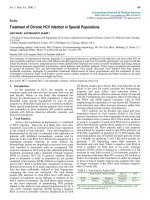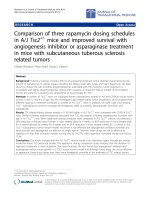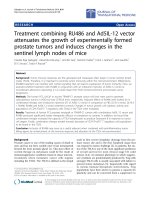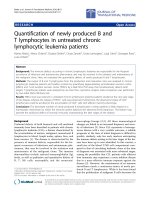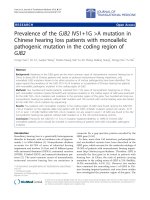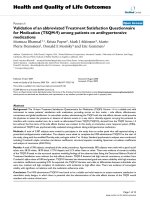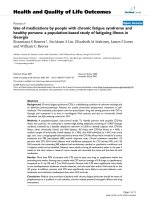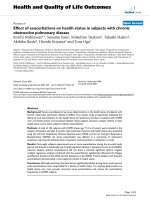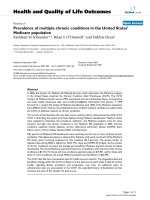báo cáo hóa học:" Treatment of chronic lateral ankle instability: a modified broström technique using three suture anchors" pot
Bạn đang xem bản rút gọn của tài liệu. Xem và tải ngay bản đầy đủ của tài liệu tại đây (699.15 KB, 6 trang )
BioMed Central
Page 1 of 6
(page number not for citation purposes)
Journal of Orthopaedic Surgery and
Research
Open Access
Technical Note
Treatment of chronic lateral ankle instability: a modified broström
technique using three suture anchors
Xinning Li*
1
, Timothy J Lin
2
and Brian D Busconi
1
Address:
1
University of Massachusetts Medical Center, Division of Sports Medicine, Dept of Orthopaedic Surgery, Room S4-827, 55 Lake Avenue
North, Worcester, MA 01655, USA and
2
University of Massachusetts Medical School, Worcester, MA 01655, USA
Email: Xinning Li* - ; Timothy J Lin - ; Brian D Busconi -
* Corresponding author
Abstract
Ankle sprains are very common injuries seen in the athletic and young population. Majority of
patients will improve with a course of rest and physical therapy. However, with conservative
management about twenty percent of all patients will go on to develop chronic lateral ankle
instability. This manuscript describes our detailed surgical technique of a modification to the
original Broström procedure using three suture anchors to anatomically reconstruct the lateral
ankle ligaments to treat high demand patients who have developed chronic lateral ankle instability.
The rationale for this modification along with patient selection and workup are discussed. Both the
functional outcomes at the two year follow up along with the complications and the detailed
postoperative rehabilitation protocol for the high demand athletes are also presented. This
modified Broström procedure is shown in both illustrative format and intra-operative photos.
Background
Ankle sprains are common injuries seen in the young and
athletic population with majority of the cases involving
the lateral ligamentous complex [1-3]. Much of the litera-
ture has been written about the operative and non-opera-
tive treatment of severe lateral ankle sprains and the
possible sequelae of chronic instability of the ankle [4-
14]. A majority of the patients will improve following a
treatment protocol involving a period of rest and physical
therapy. However, it has been noted in previous studies
that as many as twenty percent of patients will have
chronic symptomatic ankle instability [5,15,16]. The
treatment of chronic ankle instability in patients who
have failed a course of supervised and aggressive physical
therapy, poses a challenge to the orthopedic surgeon.
Many different techniques have been described in the
operative treatment for chronic lateral ankle instability
that involves either anatomic or non-anatomic repairs
(tenodesis) [13,14,17-20]. Broström described an ana-
tomic primary repair technique in 1966 [21] and Gould
subsequently modified this technique by advancing the
extensor retinaculum to reinforce the repair [22].
This manuscript describes another variant to the Gould
modified Broström repair using three suture anchors. This
technique involves anatomic reconstruction of both the
Anterior Talo-fibular Ligament (ATFL) and Calcaneal
Fibular Ligament (CFL). A third suture anchor is also used
proximal to the ATFL insertion to reinforce the repair ana-
tomically.
Surgical Technique
Each patient received general anesthesia with a peroneal
nerve block. The patient was placed in a supine position
with a towel bump under the ipsilateral buttock. A thigh
tourniquet was utilized during the operation to control
Published: 2 December 2009
Journal of Orthopaedic Surgery and Research 2009, 4:41 doi:10.1186/1749-799X-4-41
Received: 25 August 2009
Accepted: 2 December 2009
This article is available from: />© 2009 Li et al; licensee BioMed Central Ltd.
This is an Open Access article distributed under the terms of the Creative Commons Attribution License ( />),
which permits unrestricted use, distribution, and reproduction in any medium, provided the original work is properly cited.
Journal of Orthopaedic Surgery and Research 2009, 4:41 />Page 2 of 6
(page number not for citation purposes)
bleeding (250 mmHG). Once the patient was anesthe-
tized, their ankle was evaluated for baseline range of
motion and laxity. Next, a two inch curvilinear incision
was made anteriorly over the lateral malleoli with a #15
blade (Figure 1). Care is taken to identify and avoid the
sural nerve. The proximal edge of the inferior extensor ret-
inaculum was then identified, carefully dissected and
mobilized (Figure 2). The lateral ankle capsule was then
identified along with the remnants of the anterior tal-
ofibular ligament. The calcaneofibular ligament (CFL)
can be identified at the tip of the distal fibula with inferior
retraction of the peroneal tendons (Figure 3). We also
inspected the peroneal tendons for tears at this time. The
capsule was then divided from the distal fibula and
extended about one centimeter proximally via sub perio-
steal elevation with a #15 blade.
The lateral ankle gutter and the lateral talar dome were
also inspected for loose bodies and osteochondral inju-
ries. Next, the distal tip if the fibula at the ATFL and CFL
footprint was debrided with a curette and surgical blade,
then a burr was used to lightly decorticated the bone in
order to provide a bleeding bony bed for healing and
suture anchor placement. Drill holes were then made at
the ATFL and CFL insertion site. A Panalok (Mitek) pan-
acryl suture anchor was placed at the anatomic foot print
of each, the ATFL and CFL, respectively in the distal fibula.
A third Panalok (Mitek) suture anchor was inserted
approximately 1 cm above the ATFL insertion with the
same drill hole technique (Figure 4). Care was taken to
make sure that the drill hole tunnels did not intersect with
each other. Figure 5 shows the suture anchor (Mitek - 4.1
× 6.0 mm with #2 Panacryl absorbable suture) that we uti-
lized for our procedure. The suture from anchor #1 was
placed into the CFL in a horizontal mattress fashion. The
inferior limb of anchor #2 was placed into the capsule just
inferior to the ATFL, the superior limb (Anchor #2) and
the inferior limb of anchor #3 was placed into the ATFL
ligament using a horizontal mattress. Lastly, the superior
limb of suture #3 was place above the ATFL into the cap-
sule. Please see Figure 4 for the exact orientation of the
sutures.
Next, the remnants of the ATFL and CFL along with a cap-
sular-periosteal flap were tied down to the three suture
anchors with the foot at neutral dorsiflexion and slight
eversion (Figure 6). The extensor retinaculum was then
advanced and repaired to the periosteum of the distal fib-
ula (Figure 7) to reinforce our repair with interrupted 0
vicryl sutures (this is also done with the foot in neutral
dorsiflexion and slight eversion. Lastly, the skin was
closed subcutaneously using 2-0 vicryl sutures (Figure 8),
followed by 4-0 nylon interrupted stitches. Wound was
dressed with xeroform and sterile 4 × 4 kurlex and webrile.
Post Operative Protocol
Post-operatively, all patients were placed in a well-padded
posterior and sugar-tong splint with the foot in neutral
and slight eversion with non weight bearing instructions
until their follow-up visit in 10 to 14 days. Toe range of
motion was encouraged in order to diminish venous sta-
sis. Aspirin of 325 mg PO daily for 14 days was also pre-
scribed for each patient. At the first postoperative follow-
up visit, ankle incision was inspected and the stitches were
removed. The patients were then placed in a short-leg
walking cast for the next 2 weeks. Protected and progres-
A 2 inch curvilinear incision is made just anterior to the lateral malleoli with a #15 bladeFigure 1
A 2 inch curvilinear incision is made just anterior to the lateral malleoli with a #15 blade. Care is taken to identify
and avoid the sural nerve.
Journal of Orthopaedic Surgery and Research 2009, 4:41 />Page 3 of 6
(page number not for citation purposes)
sive weight bearing was allowed over the following 2
weeks. During weeks 4 to 6, patients were then placed in
a protective ASO (ankle support orthosis) brace and
started on gentle active assisted range of motion of the
ankle. Proprioception and strength training were also
started during the 6 to 8 week interval with plyometrics
starting at 8 to 12 weeks. Patients were allowed to return
to sports or normal activities without any limitations
shortly thereafter week 16. If the patient is a highly com-
petitive athlete, then the post operative protocol was
modified to include straight running and functional activ-
ities at about the 12
th
post operative week. Sports specific
drills and cutting activities were allowed after week 16.
Discussion
The majority of lateral ankle ligament injuries will resolve
with non-operative care. Konradsen, et al. have showed
that eighty percent of their patients with lateral ankle lig-
ament injuries improved when treated with a course of
supervised rehabilitation specifically aimed at proprio-
ceptive and strength training with a seven year follow up
[9]. However, there are still about twenty percent of
patients that will fail conservative management and go
onto develop chronic instability. Both anatomic and non-
anatomic techniques have been utilized to treat chronic
lateral ankle instability in the literature.
The rationale for this particular modification to the origi-
nal Broström technique is the improved surgical versatil-
ity of utilizing suture anchors for the repair of the ATFL,
CFL, and the anterior capsule. First, the placement of the
suture anchor at the footprints of the ATFL and CFL allows
the surgeon to address each of the ligaments individually
and the ability to repair them anatomically. Secondly,
using anchors with sutures that are tied to the distal
aspects of the ligaments will allow the surgeon the ability
to better tighten the lateral ankle structures in comparison
to primary repair. This particular technique also adds a
third suture anchor approximately 1 cm above the ATFL
insertion site, which is used to tighten the confluence of
the proximal aspect of the ATFL ligament with the lateral
ankle capsule. This is an important step because in
patients with lateral ankle instability and tear of the ATFL,
The proximal edge of the inferior extensor retinaculum is identified and carefully dissected then mobilized for advancement later in the procedureFigure 2
The proximal edge of the inferior extensor retinaculum is identified and carefully dissected then mobilized for
advancement later in the procedure.
The lateral ankle capsule was then identified along with the remnants of the anterior talofibular ligamentFigure 3
The lateral ankle capsule was then identified along
with the remnants of the anterior talofibular liga-
ment. The calcaneofibular ligament (CFL) can be identified
at the tip of the distal fibula with inferior retraction of the
peroneal tendons.
Journal of Orthopaedic Surgery and Research 2009, 4:41 />Page 4 of 6
(page number not for citation purposes)
sometimes it is very difficult to distinguish the margin of
the ATFL with the lateral capsule. Thus the addition of the
third suture anchor allows further anatomic reinforce-
ment of the repair without compromising ankle motion.
Furthermore, the suture and the anchor used are absorbed
over time, thus leaving no hardware in the ankle joint.
Our patient selection for this procedure is chronic lateral
ankle instability refractory to at least a 6 months course of
formal physical therapy. Both the talar tilt and anterior
drawer stress radiographs are done in clinic with a mini
fluoroscopy to document lateral instability. It is extremely
important to compare the stress views with the contra-lat-
eral ankle as some patients may have congenital laxity.
Magnetic resonance imaging is also ordered on every
patient to evaluate for intra-articular pathology and con-
dition of the ATFL/CFL ligaments. Anyone with fractures,
significant varus mal-alignment, severe osteoarthritis of
the ankle, osteochondral dissecans lesions of the talus,
and previous failed lateral ankle ligamenteous repair or
reconstruction are not candidates for this procedure.
Important points to remember during surgery include 1)
meticulous elevation of the extensor retinaculum to leave
a cuff of tissue for advancement, 2) careful and accurate
periosteal dissection of the capsule off the fibula in order
to preserve adequate length for repair, 3) always evaluate
Two suture anchors placed at the footprint of the ATFL and CFL insertion siteFigure 4
Two suture anchors placed at the footprint of the ATFL and CFL insertion site. A third suture anchor is placed
approximately 1 cm above the ATFL insertion site to reinforce the repair. The orientation of the sutures from each anchor is
also illustrated.
Mitek - 4.1 × 6.0 mm with #2 Panacryl absorbable sutures used in our procedureFigure 5
Mitek - 4.1 × 6.0 mm with #2 Panacryl absorbable
sutures used in our procedure.
The foot was held in neutral dorsiflexion and slight eversion when the sutures from the 3 anchors were tied down to fur-ther reinforce our repairFigure 6
The foot was held in neutral dorsiflexion and slight
eversion when the sutures from the 3 anchors were
tied down to further reinforce our repair.
Journal of Orthopaedic Surgery and Research 2009, 4:41 />Page 5 of 6
(page number not for citation purposes)
the intra-articular aspect of the ankle joint looking for
loose bodies or OCD lesions, 4) when repairing the CFL,
pay attention not to incorporate the peroneal tendon into
the repair, and 5) if the CFL or ATFL is significantly short-
ened or not repairable, our bailout procedure of choice is
an allograft reconstruction of both the ATFL and CFL. Fur-
thermore, the most essential components to the success of
this procedure is to tighten the three suture anchors as
well as the extensor retinaculum with the patient's foot in
neutral and slight eversion (Figure 7) which will further
tighten up the lateral instability.
This technique was utilized by the authors in a series of
high demand athletes with chronic lateral ankle instabil-
ity and was able to return 94% of the patients to their pre-
vious sports activity level as demonstrated by the Tegner
score. Also the average Karlsson ankle functional score
was 92 +/- 5.2 and 95 +/- 3.1 at the one and two year post
operative time frame, respectively. Only 3 patients out of
52 (6%) had a decrease in range of motion of greater than
5 degrees at the two year post operative follow up and
there was no loss in subtalar motion. The major compli-
cation rate included a 6% re-rupture rate (3/53 patients)
past the 1 year post operative period due to traumatic
injuries in competition with no neurological injuries. We
had several superficial wound infections that were treated
and resolved with a course of oral antibiotics. Also a few
patients had persistent ankle swelling, however, all of
them resolved at the 6 months follow-up visit [23].
Conclusion
Operative management of chronic lateral ankle instability
using anatomic technique with three suture anchors will
provide a stable fixation for patients with chronic lateral
ankle instability refractory to conservative management to
return to their normal functional activity level. This mod-
ification also provides the surgeon with another alterna-
tive technique to the Broström repair.
Competing interests
The authors declare that they have no competing interests.
Authors' contributions
XL and BB have contributed to the conception/design,
data collection/interpretation, and drafting/revising of the
manuscript. XL and TL created the illustrations and intra-
operative photos used in this manuscript. All authors
approved the final manuscript.
References
1. Barker H, Beynnon B, Renstron P: Ankle injury risk factors in
sports. Sports Medicine 1997, 23:69-74.
2. Ferran N, Maffulli N: Epidemiology of sprains of the lateral
ankle ligament complex. Foot Ankle Clinics 2006, 11(3):659-662.
3. Fong D, Hong Y, Chan L, et al.: A systematic review on ankle
injury and ankle sprain in sports. Sports Medicine 2007,
37(1):73-94.
4. Good C, Jones M, Livingstone B: Reconstruction of the lateral lig-
aments of the ankle. Injury 1975, 7:63-65.
5. Holmer P, Sondergaard L, Konradsen L, et al.: Epidemiology of
sprains in the lateral ankle and foot. Foot and Ankle International
1994, 15:72-74.
6. Karlsson J, Bergsten T, Lansinger O: Lateral instability of the
ankle treated by the Evans procedure: A long-term clinical
and radiological follow-up. Journal of Bone and Joint Surgery 1988,
70B:476-480.
7. Karlsson J, Bergsten T, Lansinger O, et al.: Reconstruction of the
lateral ligaments of the ankle for chronic lateral instability. J
Bone Joint Surg Am 1988, 70(4):581-588.
8. Karlsson J, Peterson L: Evaluation of ankle joint function: the
use of a scoring scale. The Foot 1991, 1:15-19.
9. Konradsen L, Bech L, Ehrenbjerg M, et al.: Seven years follow-up
after ankle inversion trauma. Scand J Med Sci Sports 2002,
12:129-135.
The extensor retinaculum was then advanced and repaired to the periosteum of the distal fibulaFigure 7
The extensor retinaculum was then advanced and
repaired to the periosteum of the distal fibula.
The incision was closed subcutaneously using 2-0 vicryl suturesFigure 8
The incision was closed subcutaneously using 2-0 vic-
ryl sutures.
Publish with BioMed Central and every
scientist can read your work free of charge
"BioMed Central will be the most significant development for
disseminating the results of biomedical research in our lifetime."
Sir Paul Nurse, Cancer Research UK
Your research papers will be:
available free of charge to the entire biomedical community
peer reviewed and published immediately upon acceptance
cited in PubMed and archived on PubMed Central
yours — you keep the copyright
Submit your manuscript here:
/>BioMedcentral
Journal of Orthopaedic Surgery and Research 2009, 4:41 />Page 6 of 6
(page number not for citation purposes)
10. Krips R, Van Dijk C, Lethtonen H: Sports activity level after sur-
gical treatment of chronic anterolateral ankle instability.
American Journal of Sports Medicine 2002, 30:13-19.
11. Liu S, Baker C: Comparison of Lateral Ankle Ligamentous
Reconstruction Procedures. American Journal of Sports Medicine
1994, 22(3):313-317.
12. Pijnenburg A, Bogaard K, Krips R, et al.: Operative and functional
treatment of rupture of the lateral ligament of the ankle: A
randomized, prospective trial. Journal of Bone and Joint Surgery
2003, 85B:525-530.
13. Snook G, Chrisman O, Wilson T: Long-term results of the Chris-
man-Snook operation for reconstruction of the lateral liga-
ments of the ankle. J Bone Joint Surg Am 1985, 67(1):1-7.
14. Van der Rijt AJ, Evans G: The long-term results of Watson-Jones
tenodesis. Journal of Bone and Joint Surgery 1984, 66B:371-375.
15. Balduini F, Vegso J, Torg J, et al.: Management and rehabilitation
of ligamentous injuries to the ankle. Sports Medicine 1987,
4:364-380.
16. Colville M: Surgical treatment of the unstable ankle. Journal of
American Academy Orthopaedic Surgery 1998, 6:368-377.
17. Fujii T, Kitaoka HB, Watanabe K, et al.: Comparison of Modified
Brostrom and Evans Procedures in Simulated Lateral Ankle
Injury. Medicine and Science in Sports and Exercise 2006,
38(6):1025-1031.
18. Reigler HF: Reconstruction for lateral instability of the ankle.
Journal of Bone and Joint Surgery 1984, 66A:336-339.
19. Sugimoto K, Takakura Y, Akiyama K: Long-term results of
Watson-Jones tenodesis of the ankle. Clinical and radio-
graphic findings after ten to eighteen years of follow-up. Jour-
nal of Bone and Joint Surgery 1998, 80A:1587-1596.
20. Vainionpää S, Kirves P, Läike E: Lateral instability of the ankle
and results when treated by the Evans procedure.
Am J Sports
Med 1980, 8(6):437-439.
21. Brostrom L: Sprained Ankles IV: Surgical treatment of
"chronic" ligament ruptures. Acta Chir Scand 1966, 132:551-565.
22. Gould N, Seligson D, Gassman J: Early and late repair of lateral
ligaments of the ankle. Foot and Ankle International 1980, 1:84-89.
23. Li X, Killie H, Guerrero P, et al.: Anatomical reconstruction for
chronic lateral ankle instability in the high-demand athlete:
Functional outcomes after the modified brostrom repair
using suture anchors. American Journal of Sports Medicine 2009,
37(3):488-494.
